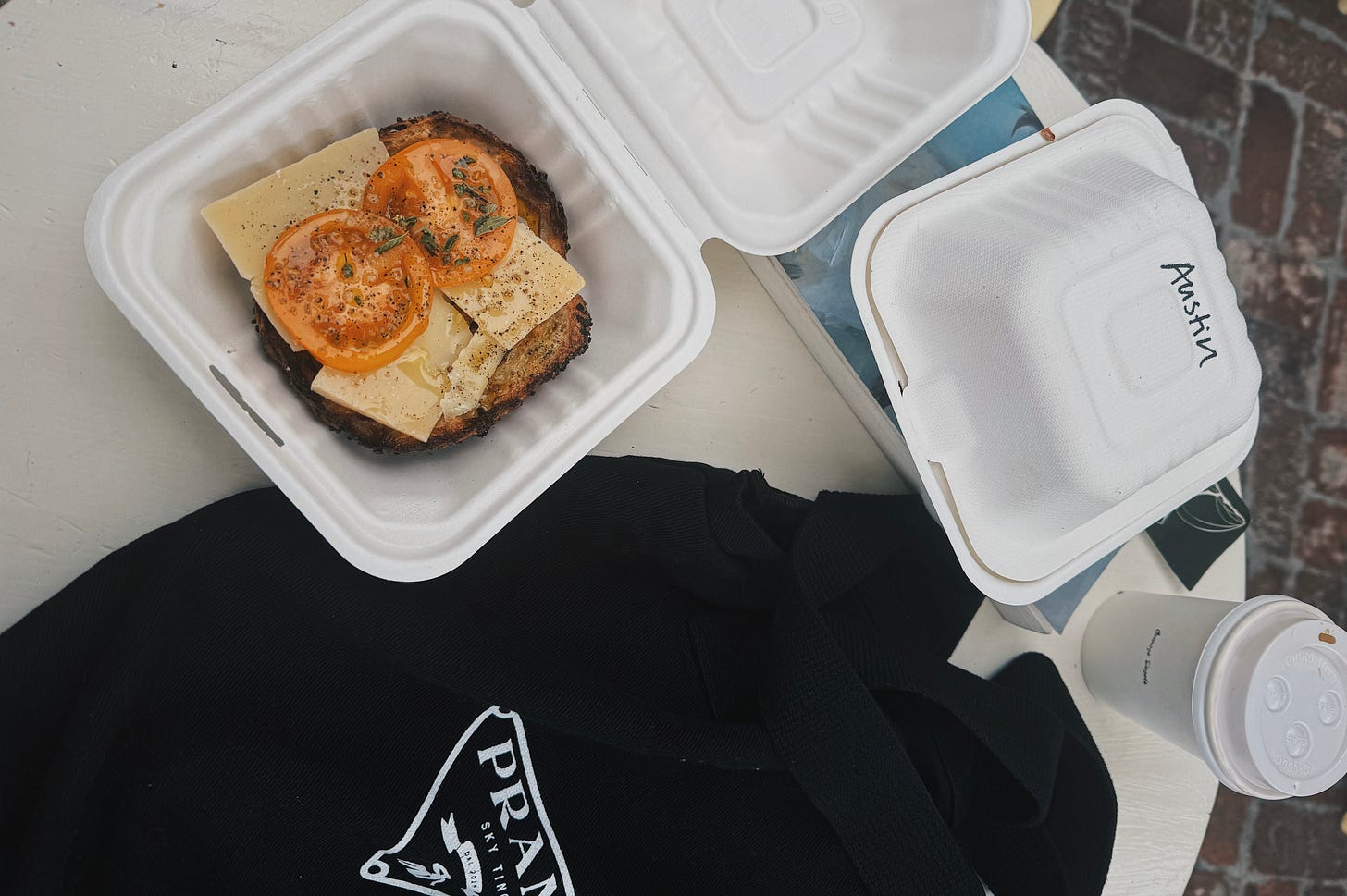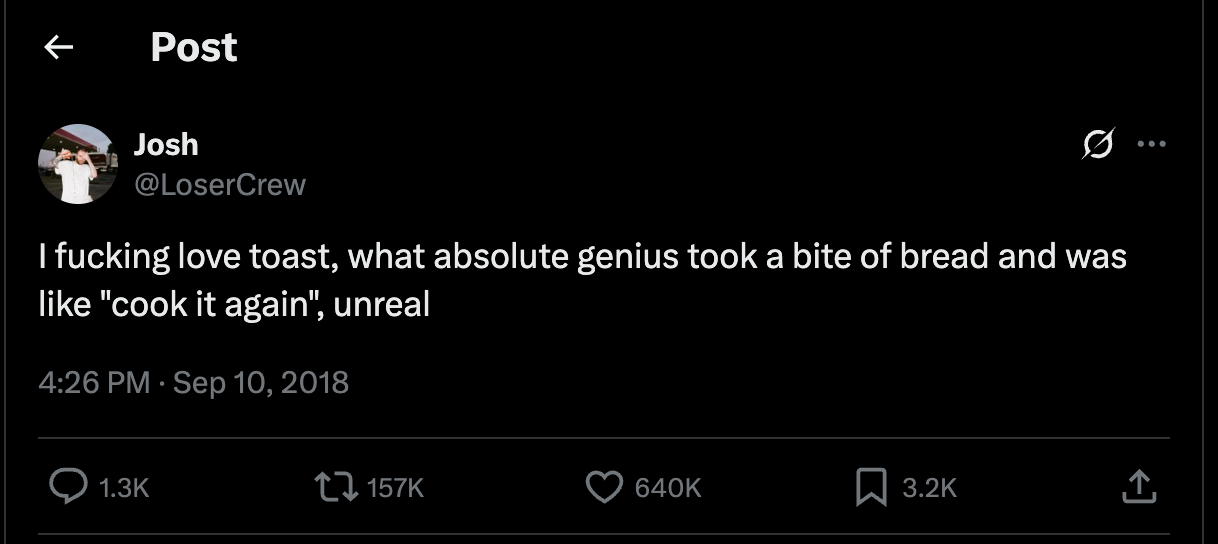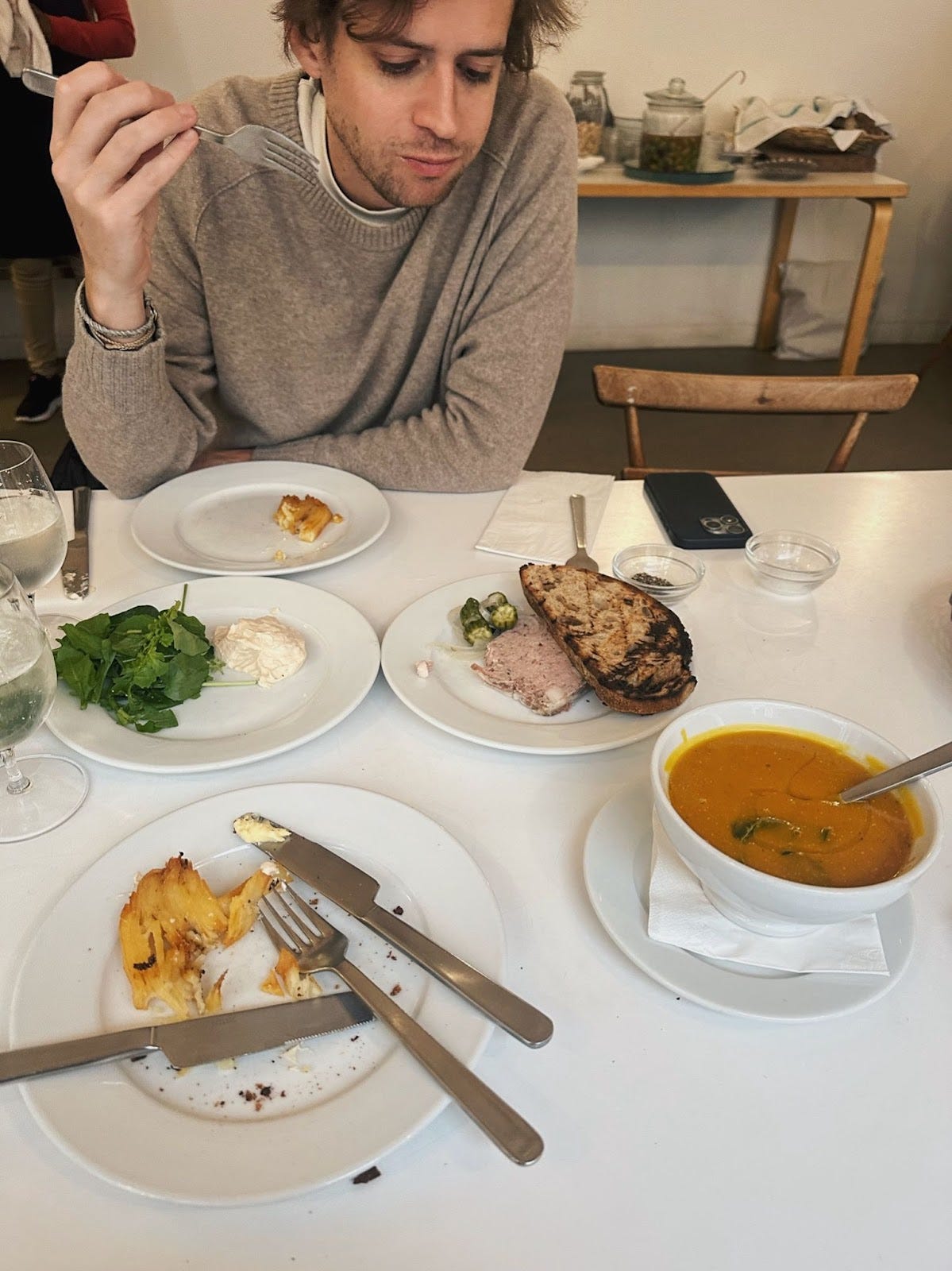A few times a month, I’ll roast a whole chicken, scattering vegetables around the cast iron pan, mixing the fat in with rice, and simmering the carcass into soup. I can’t get away from celery salads blending acid and cheese and nuts. Whenever I need to clean out my fridge, the straggling ingredients turn into fried rice.
There are a few base dishes I’ve repeated hundreds of times. Recipes, real and remembered, that I’ve spent a decade getting a little bit better at on each iteration. Despite all of that, the kitchen task I get complimented on the most is toast.
I’ve had a surprising amount of people that I cook for regularly ask me, “How do I make toast?” It always makes me think of this meme:
“Cook the bread again” is, indeed, enough to get you to perfectly passable toast. If you scroll through influential cookbooks, new and old, that’s oftentimes the only instructions you’ll get. Here’s Gabrielle Hamilton in Prune on the toast that holds together her sardine sandwich:
“Slice day-old bread on the thin side — as thin as your iPhone — then toast under the salamander, both sides.”
You’ll find that simple “toast on both sides” recommendation all over, especially in cheffier cookbooks. Chefs are used to having a salamander broiler and limited time. There’s no more reliable way to get a good enough final product than to quickly let the sally rip. It’s the professional kitchen equivalent of your at-home toaster. But I could not be more strongly anti-toaster. Here’s Ignacio Mattos in the Estela book, explaining his approach to his brunch toast with lardo and jam:
“You don't need to be a good cook or a cook at all to make good toast; you just need to be hungry. But when you're starved, you tend to take shortcuts. It sometimes helps to calm down and proceed with care. That is the case here, with a toast that glistens in a way that's almost improper.”
Ignacio pan fries his toast, a method that when done with care leads to an ideal texture of charred edges, crispy exterior and cushy interior. Mason Hereford demonstrates just how deep that level of care can go in Turkey and the Wolf:
Bread isn't just a vehicle, it's a component. Consider its crustiness and toastability, its density and size and flavor. Don't use wheat bread just because it seems healthier. Use it because you've thought strategically about how its subtle sweetness will bond with its cheese-sauce-topping family.
Whether you use butter, olive oil, or some other cool fat, [toasting bread in a pan] gives you the best-looking, best-smelling, best-tasting crust. It also rejuvenates day-three bread better than any other method, if you ask me.
After bread toasts, it must rest … going straight into the sandwich build after toasting creates suboptimum architecture — the bottom slice gets trapped between the toppings and the cutting board, sogging out and compromising the structural integrity.
The answer is to rest the toasted bread on a wire rack … That way, the bread has a chance to breathe so it can retain its crisp exterior and become tectonically sound sandwich toast.
Cooking is an escape, but one that activates my brain more than shutting it off. With a good playlist on, a drink in my hand and all the mise en place organized on a counter, I’m at my most present, paying attention to sounds and smells and instinct. That peaks when I have two pieces of toast going in a big bed of olive oil.
Forgettable toasting methods can get you to an enjoyable dish pretty easily. You’ve got carbs and fats and crunch. It works. But every additional layer of care added can make it a more memorable bite, from ensuring full contact of bread to fat to the pan to temperature controlling the oil and butter. Toast is what I make for friends when they’re spiraling, and what I make for myself when I need to reset.
If I haven’t finished a novel in a while, I’ll track down some Sally Rooney-adjacent page turner to accelerate my reading flow state. If I’m out of a regular cooking rotation, I’ll swing by LA Homefarm for a $21, gluten-free, rice & teff loaf from Gjusta — one of LA’s most absurd yet worth-it indulgences — and start making toasts.
(Since I’m neither in the throes of a mid-pandemic breakdown nor a divorce, I refuse to bake my own bread. There’s so much good bread within minutes of you. Start there).
Next, I’ll get all the necessary ingredients together on a cutting board near the stove, like:
Olive oil
Room temperature butter
A peeled garlic clove
Cheese or a flavored aioli
Anchovies
Small, simply-roasted vegetables
Cured meat
Herbs
Chile oil
Fried shallots
I don’t believe in stuffed or stacked foods, but in particular I’m out on loaded toasts and sandwiches. It’s why burrito culture also has never made much sense to me. In that IG-approved glob of messiness, you don’t actually end up tasting anything, just a mishmash of textures. Instead, I prefer a well-prepared, well-seasoned base toast with no more than three things on top of it.
To get there, crank a cast-iron pan on high heat for about a minute and then lower down to medium-high. Once the pan is hot, put in a little more olive oil than you think you’ll need. Timing and tempering everything well is how you avoid tasting burnt oil. Drop in no more than two slices of bread at a time, move them around a bit in the pan, and then press down with some kind of weight.
From here, don’t use a timer. Sometimes you’ll peek too early, and know next time to be more patient. Or you might over-char one side. This is how you learn. When ready, remove the weight, then use a fish spatula to check the bread and flip. I like a slightly thicker than iPhone width bread, toasted about 20% past golden brown. You know your own preference when you see it.
While the bread cooks on its second side, drop one small rectangle of butter on top and let it melt. Then transfer the bread to a rack to avoid steaming and rub both sides with a raw, peeled garlic clove. I like to finish the bread with a little bit of Maldon, just to amp up the flavor a touch more.
You’ve got a great bite waiting for you already. My most common add-on is to spread room temp butter across the bread, cover with a couple anchovies and then finish with a lot of black pepper and a little additional olive oil. Play around with whatever you already have in the house that looks good. I don’t like buying ingredients specifically for toast. That’s not the point. Make the toast perfect and top it with something good, rather than accepting mediocre toasting methods supporting a pre-constructed idea.






Love a proper toast. I once made a covid-era cooking video about cast iron toast (I would share but I have a fucking ridiculous half-assed moustache that is best not seen) and I got roasted by several of my friends for making a toast video. But still - it's an art form! Thanks for celebrating the simple things.
Instantly subscribed. This was perfect.